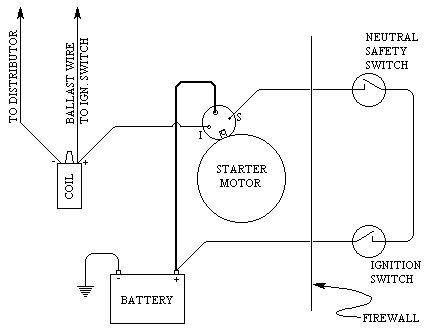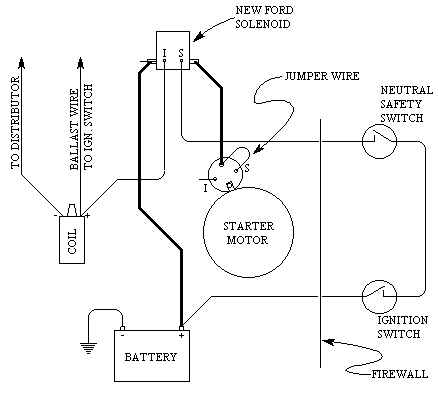Authored by Wes Vann, last revised on March 28, 1997
PLEASE NOTE: Any time that you work on the electrical system of your car, disconnect the battery! (I like using a SCCA approved battery disconnect switch)
The intent of this page is to clear up the questions in regards to adding a Ford starter solenoid and to help with the dreaded "heat soak" that seems to get all of us Chevy guys (and also girls, in order to be PC) at one time or another (normally while trying to show off during that first date).
This information is "general" in nature and shouldn't be considered as exactly what you have in your garage. (it is exactly like the car in my garage)
Other than differences in the gearing, (to accommodate different flywheel sizes) there are basically two different starter motors. A low torque and a high torque. You can tell a set-up with the high torque starter motor due to a spacer being required between the solenoid and the electrical connection to the starter.

THIS IS THE ORIGINAL GM WIRING CONFIGURATION
The battery wire to the solenoid in the stock configuration is hot at all times.
The sequence of events that happens in the standard GM when you hit the starter is as follows;
1. The electricity has to go from the starter switch through the loom to the neutral safety switch.
2. If you are in park (or neutral) the electricity then goes through the loom to the stock solenoid "s" terminal.
3. When the "s" terminal goes hot, it energizes the solenoid. This causes the plunger to throw the starter gear out to the ring gear (flywheel). It also closes an internal set of contacts that sends electricity to the starter motor and also to the "i" terminal.
4. The starter motor doesn't get power until the solenoid contacts are closed. The wire from the "i" terminal is a ballast resistor bypass for the coil. It gives a solid 12 volts to the coil during cranking.
Here is where a problem is encountered. It takes a fair amount of current to energize the stock solenoid when hot. Due to the amount of resistance in the wiring set-up, it may not be possible to supply the required current. This is where the Ford solenoid comes into play.
If you question this being the problem, you could add a temporary wire from the "s" terminal on the solenoid, to near the battery. When you have a problem starting your car, touch the end of the wire to the positive terminal on the battery. If the car cranks over, you know that the Ford solenoid will solve the problem. NOW TAKE NOTE!!!!! This is how that thief down the road would hot wire your car and you just made it real easy! ALSO NOTE!!!!!! You have bypassed the neutral safety switch with this wire and you could start the car with it in gear and have it drive away without you!

THIS IS THE MODIFIED WIRING WITH THE FORD SOLENOID
If you are running an HEI distributor, don't worry about wiring to "i" terminals.
1. The wire that goes to the "s" terminal on the GM solenoid (closest to the block) is removed and wired to the "s" terminal on the Ford solenoid.
2. The wire that goes to the "i" terminal on the GM solenoid (farthest from the block) is removed and wired to the "i" terminal on the Ford solenoid. The "i" terminal on the GM solenoid will not be used. When you purchase the Ford solenoid, make sure that it has the "i" terminal if required for non-HEI distributors.
3. The battery cable is removed from the GM solenoid and is put on one of the large terminals on the Ford solenoid.
4. A battery cable is run from the other large terminal on the Ford solenoid to the large terminal on the GM solenoid.
5. Also on the large terminal on the GM solenoid, you have to add a heavy gauge (10 gauge) wire to the "s" terminal on the GM solenoid.
Now, this is what happens when you hit the start switch;
1. The electricity from the starter switch only has to energize the Ford solenoid (that is mounted in a relatively cool location).
2. The "battery" cable to the GM solenoid goes hot. The Ford "i" terminal also goes hot, providing non-ballast voltage to the coil.
3. The GM solenoid now gets a solid "high capacity" current supply and works the plunger and contacts. The internal contacts send voltage to the starter motor.
There are a few things that should be noted.
This set-up DOES NOT make the GM solenoid any cooler. It just gives it a better current supply. Anything that can be done to shield the starter from the header heat would be beneficial. There are several heat shields on the market and even GM makes one.
Always be sure that any wiring doesn't come in contact with the exhaust pipes.